Math Assessment Self Reflection: Teaching and Learning Strategies
VerifiedAdded on 2023/03/20
|5
|1288
|84
Homework Assignment
AI Summary
This assignment is a self-reflection on the use of various assessment tools in math education, particularly at the early childhood level. The student explores the importance of assessment in grading, monitoring, and resource allocation, aiming to improve both learning and teaching. The reflection highlights the benefits of using diverse assessment methods to understand students' strengths and weaknesses, leading to more qualitative insights and reduced assessment burden. The author discusses the challenges faced, such as selecting effective tools and administering them efficiently, and how these were overcome through research and strategic planning. The reflection concludes with a discussion of the author's growth in understanding child development, class interaction, and the development of lessons and assessment, ultimately leading to a paradigm shift in the approach to education and intervention strategies. The author emphasizes the value of self-reflection in the assessment process and its broader impact.
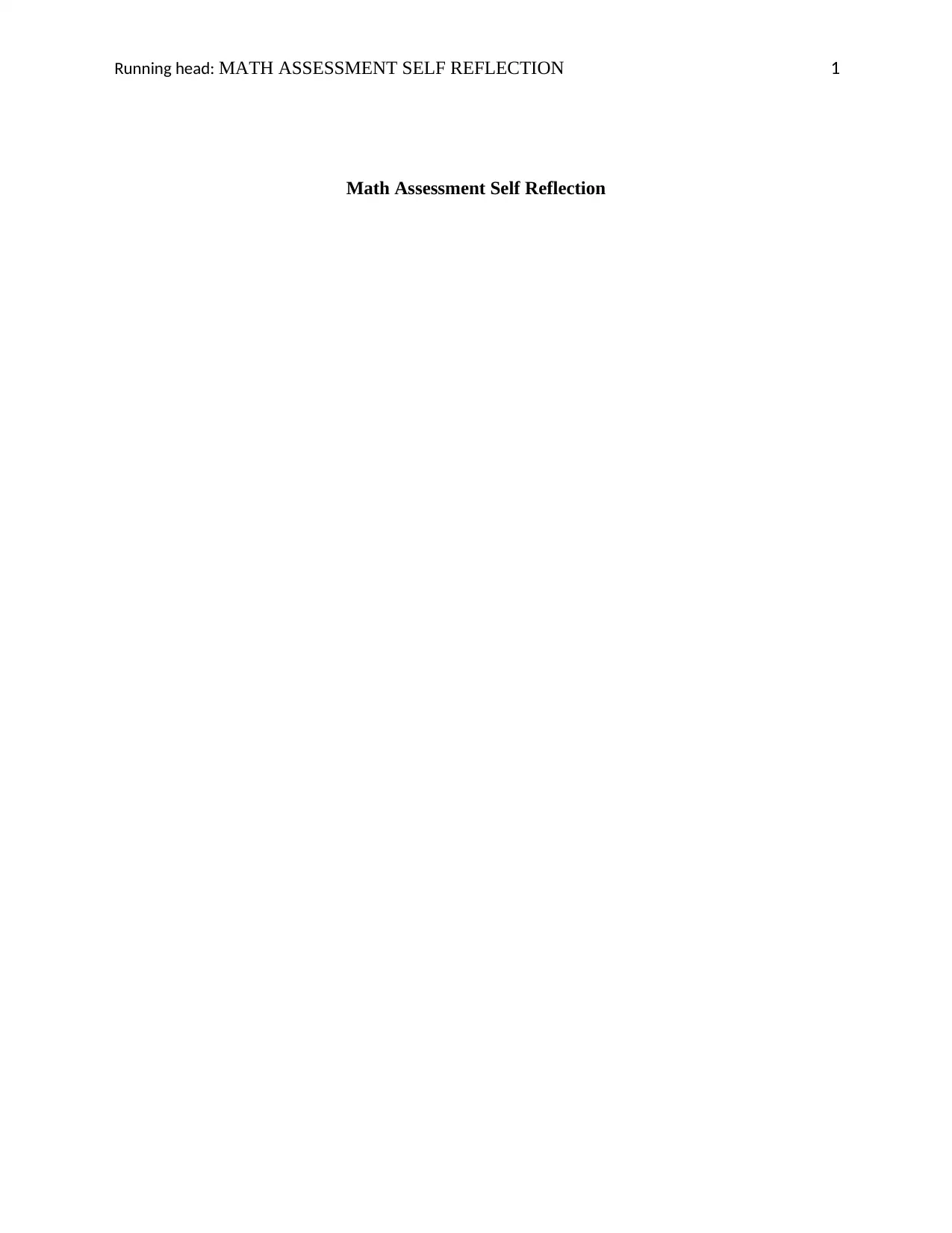
Running head: MATH ASSESSMENT SELF REFLECTION 1
Math Assessment Self Reflection
Math Assessment Self Reflection
Paraphrase This Document
Need a fresh take? Get an instant paraphrase of this document with our AI Paraphraser
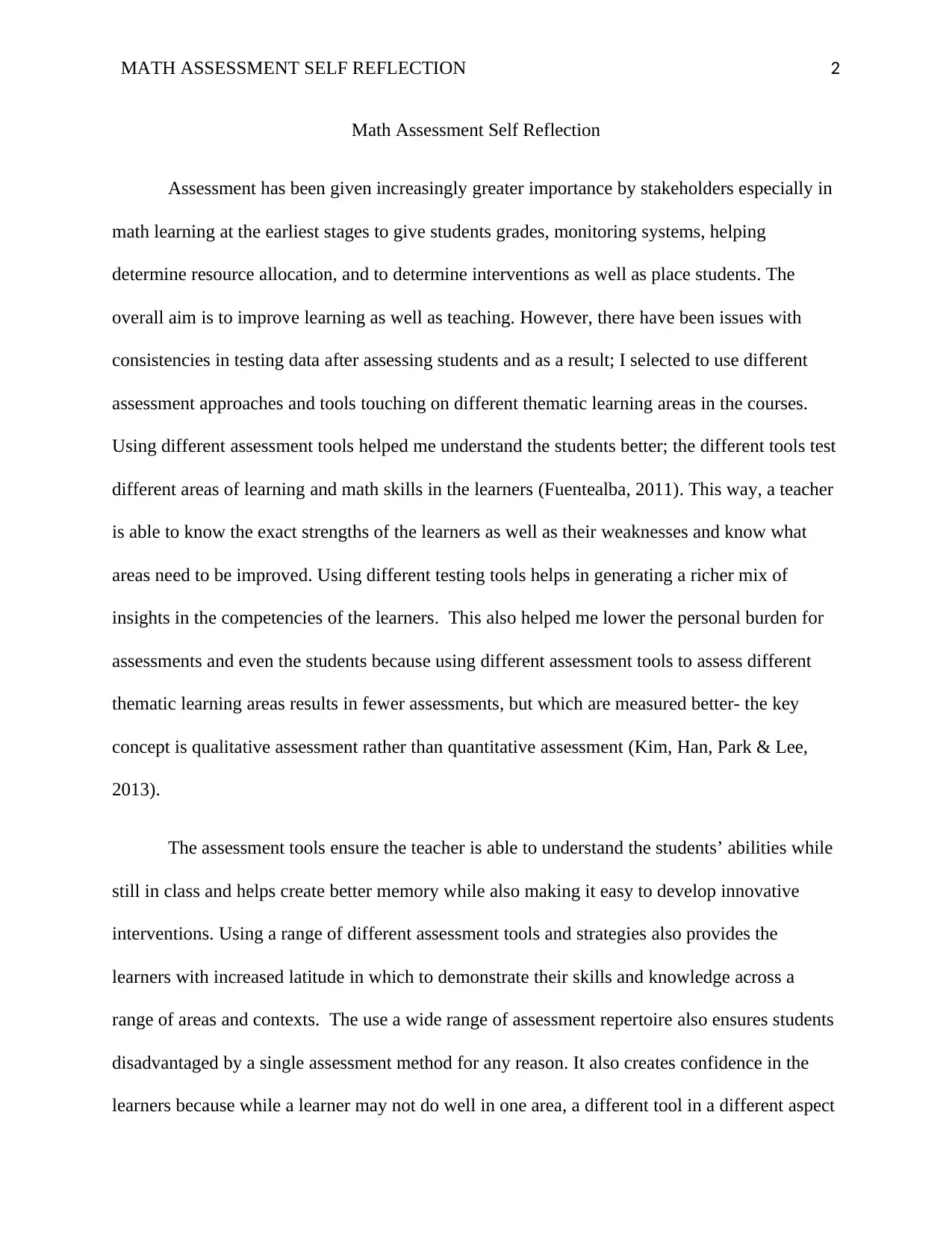
MATH ASSESSMENT SELF REFLECTION 2
Math Assessment Self Reflection
Assessment has been given increasingly greater importance by stakeholders especially in
math learning at the earliest stages to give students grades, monitoring systems, helping
determine resource allocation, and to determine interventions as well as place students. The
overall aim is to improve learning as well as teaching. However, there have been issues with
consistencies in testing data after assessing students and as a result; I selected to use different
assessment approaches and tools touching on different thematic learning areas in the courses.
Using different assessment tools helped me understand the students better; the different tools test
different areas of learning and math skills in the learners (Fuentealba, 2011). This way, a teacher
is able to know the exact strengths of the learners as well as their weaknesses and know what
areas need to be improved. Using different testing tools helps in generating a richer mix of
insights in the competencies of the learners. This also helped me lower the personal burden for
assessments and even the students because using different assessment tools to assess different
thematic learning areas results in fewer assessments, but which are measured better- the key
concept is qualitative assessment rather than quantitative assessment (Kim, Han, Park & Lee,
2013).
The assessment tools ensure the teacher is able to understand the students’ abilities while
still in class and helps create better memory while also making it easy to develop innovative
interventions. Using a range of different assessment tools and strategies also provides the
learners with increased latitude in which to demonstrate their skills and knowledge across a
range of areas and contexts. The use a wide range of assessment repertoire also ensures students
disadvantaged by a single assessment method for any reason. It also creates confidence in the
learners because while a learner may not do well in one area, a different tool in a different aspect
Math Assessment Self Reflection
Assessment has been given increasingly greater importance by stakeholders especially in
math learning at the earliest stages to give students grades, monitoring systems, helping
determine resource allocation, and to determine interventions as well as place students. The
overall aim is to improve learning as well as teaching. However, there have been issues with
consistencies in testing data after assessing students and as a result; I selected to use different
assessment approaches and tools touching on different thematic learning areas in the courses.
Using different assessment tools helped me understand the students better; the different tools test
different areas of learning and math skills in the learners (Fuentealba, 2011). This way, a teacher
is able to know the exact strengths of the learners as well as their weaknesses and know what
areas need to be improved. Using different testing tools helps in generating a richer mix of
insights in the competencies of the learners. This also helped me lower the personal burden for
assessments and even the students because using different assessment tools to assess different
thematic learning areas results in fewer assessments, but which are measured better- the key
concept is qualitative assessment rather than quantitative assessment (Kim, Han, Park & Lee,
2013).
The assessment tools ensure the teacher is able to understand the students’ abilities while
still in class and helps create better memory while also making it easy to develop innovative
interventions. Using a range of different assessment tools and strategies also provides the
learners with increased latitude in which to demonstrate their skills and knowledge across a
range of areas and contexts. The use a wide range of assessment repertoire also ensures students
disadvantaged by a single assessment method for any reason. It also creates confidence in the
learners because while a learner may not do well in one area, a different tool in a different aspect
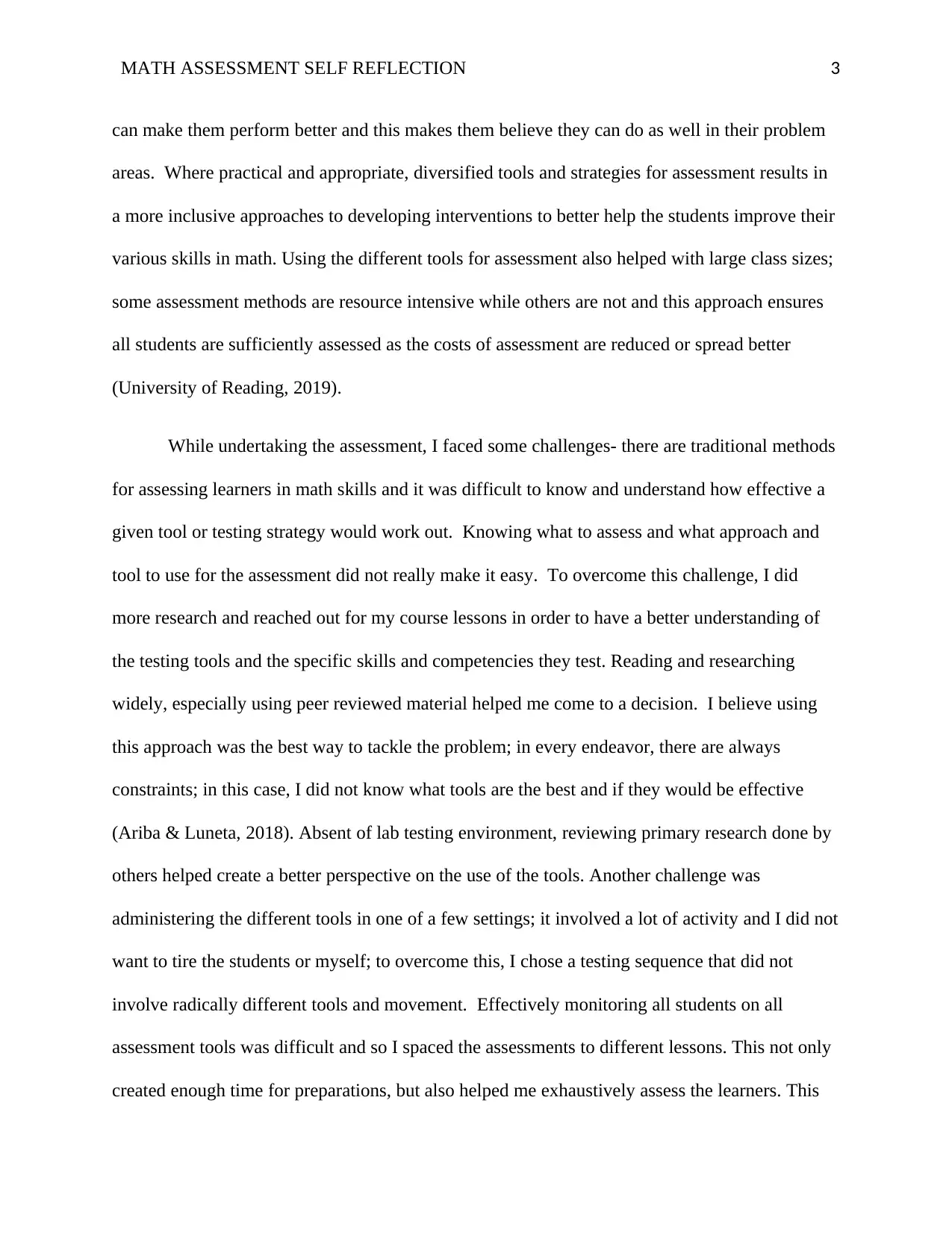
MATH ASSESSMENT SELF REFLECTION 3
can make them perform better and this makes them believe they can do as well in their problem
areas. Where practical and appropriate, diversified tools and strategies for assessment results in
a more inclusive approaches to developing interventions to better help the students improve their
various skills in math. Using the different tools for assessment also helped with large class sizes;
some assessment methods are resource intensive while others are not and this approach ensures
all students are sufficiently assessed as the costs of assessment are reduced or spread better
(University of Reading, 2019).
While undertaking the assessment, I faced some challenges- there are traditional methods
for assessing learners in math skills and it was difficult to know and understand how effective a
given tool or testing strategy would work out. Knowing what to assess and what approach and
tool to use for the assessment did not really make it easy. To overcome this challenge, I did
more research and reached out for my course lessons in order to have a better understanding of
the testing tools and the specific skills and competencies they test. Reading and researching
widely, especially using peer reviewed material helped me come to a decision. I believe using
this approach was the best way to tackle the problem; in every endeavor, there are always
constraints; in this case, I did not know what tools are the best and if they would be effective
(Ariba & Luneta, 2018). Absent of lab testing environment, reviewing primary research done by
others helped create a better perspective on the use of the tools. Another challenge was
administering the different tools in one of a few settings; it involved a lot of activity and I did not
want to tire the students or myself; to overcome this, I chose a testing sequence that did not
involve radically different tools and movement. Effectively monitoring all students on all
assessment tools was difficult and so I spaced the assessments to different lessons. This not only
created enough time for preparations, but also helped me exhaustively assess the learners. This
can make them perform better and this makes them believe they can do as well in their problem
areas. Where practical and appropriate, diversified tools and strategies for assessment results in
a more inclusive approaches to developing interventions to better help the students improve their
various skills in math. Using the different tools for assessment also helped with large class sizes;
some assessment methods are resource intensive while others are not and this approach ensures
all students are sufficiently assessed as the costs of assessment are reduced or spread better
(University of Reading, 2019).
While undertaking the assessment, I faced some challenges- there are traditional methods
for assessing learners in math skills and it was difficult to know and understand how effective a
given tool or testing strategy would work out. Knowing what to assess and what approach and
tool to use for the assessment did not really make it easy. To overcome this challenge, I did
more research and reached out for my course lessons in order to have a better understanding of
the testing tools and the specific skills and competencies they test. Reading and researching
widely, especially using peer reviewed material helped me come to a decision. I believe using
this approach was the best way to tackle the problem; in every endeavor, there are always
constraints; in this case, I did not know what tools are the best and if they would be effective
(Ariba & Luneta, 2018). Absent of lab testing environment, reviewing primary research done by
others helped create a better perspective on the use of the tools. Another challenge was
administering the different tools in one of a few settings; it involved a lot of activity and I did not
want to tire the students or myself; to overcome this, I chose a testing sequence that did not
involve radically different tools and movement. Effectively monitoring all students on all
assessment tools was difficult and so I spaced the assessments to different lessons. This not only
created enough time for preparations, but also helped me exhaustively assess the learners. This
⊘ This is a preview!⊘
Do you want full access?
Subscribe today to unlock all pages.

Trusted by 1+ million students worldwide
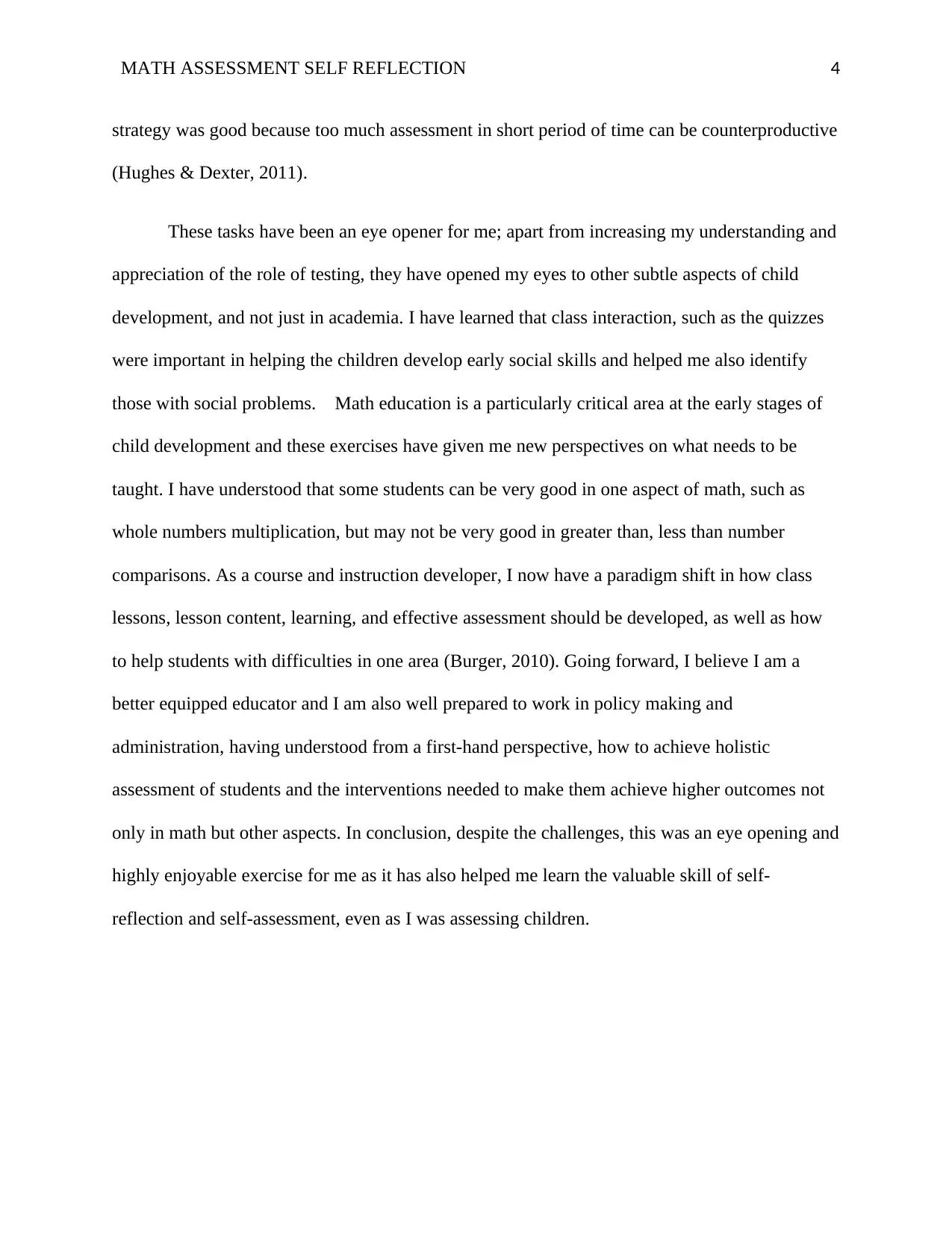
MATH ASSESSMENT SELF REFLECTION 4
strategy was good because too much assessment in short period of time can be counterproductive
(Hughes & Dexter, 2011).
These tasks have been an eye opener for me; apart from increasing my understanding and
appreciation of the role of testing, they have opened my eyes to other subtle aspects of child
development, and not just in academia. I have learned that class interaction, such as the quizzes
were important in helping the children develop early social skills and helped me also identify
those with social problems. Math education is a particularly critical area at the early stages of
child development and these exercises have given me new perspectives on what needs to be
taught. I have understood that some students can be very good in one aspect of math, such as
whole numbers multiplication, but may not be very good in greater than, less than number
comparisons. As a course and instruction developer, I now have a paradigm shift in how class
lessons, lesson content, learning, and effective assessment should be developed, as well as how
to help students with difficulties in one area (Burger, 2010). Going forward, I believe I am a
better equipped educator and I am also well prepared to work in policy making and
administration, having understood from a first-hand perspective, how to achieve holistic
assessment of students and the interventions needed to make them achieve higher outcomes not
only in math but other aspects. In conclusion, despite the challenges, this was an eye opening and
highly enjoyable exercise for me as it has also helped me learn the valuable skill of self-
reflection and self-assessment, even as I was assessing children.
strategy was good because too much assessment in short period of time can be counterproductive
(Hughes & Dexter, 2011).
These tasks have been an eye opener for me; apart from increasing my understanding and
appreciation of the role of testing, they have opened my eyes to other subtle aspects of child
development, and not just in academia. I have learned that class interaction, such as the quizzes
were important in helping the children develop early social skills and helped me also identify
those with social problems. Math education is a particularly critical area at the early stages of
child development and these exercises have given me new perspectives on what needs to be
taught. I have understood that some students can be very good in one aspect of math, such as
whole numbers multiplication, but may not be very good in greater than, less than number
comparisons. As a course and instruction developer, I now have a paradigm shift in how class
lessons, lesson content, learning, and effective assessment should be developed, as well as how
to help students with difficulties in one area (Burger, 2010). Going forward, I believe I am a
better equipped educator and I am also well prepared to work in policy making and
administration, having understood from a first-hand perspective, how to achieve holistic
assessment of students and the interventions needed to make them achieve higher outcomes not
only in math but other aspects. In conclusion, despite the challenges, this was an eye opening and
highly enjoyable exercise for me as it has also helped me learn the valuable skill of self-
reflection and self-assessment, even as I was assessing children.
Paraphrase This Document
Need a fresh take? Get an instant paraphrase of this document with our AI Paraphraser
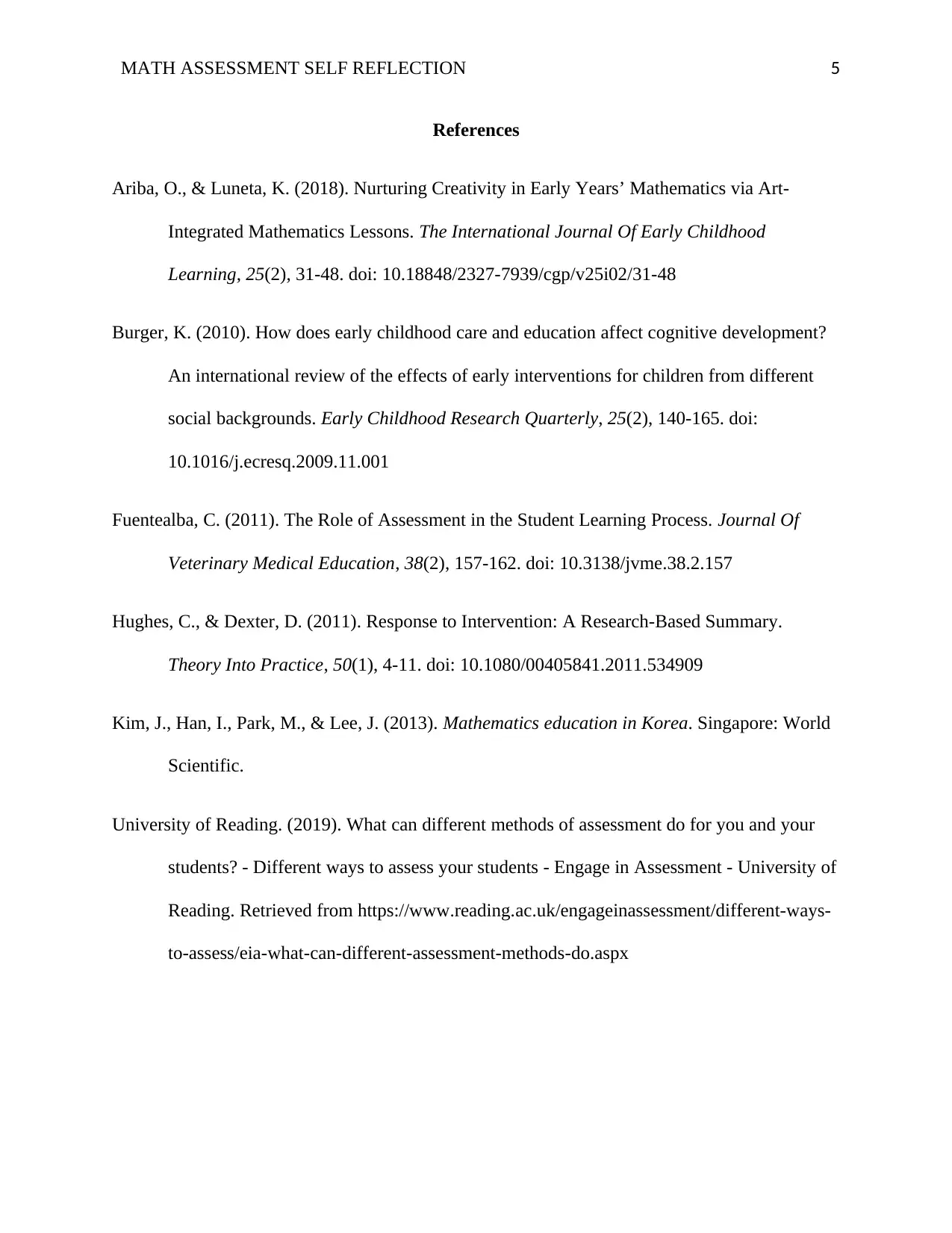
MATH ASSESSMENT SELF REFLECTION 5
References
Ariba, O., & Luneta, K. (2018). Nurturing Creativity in Early Years’ Mathematics via Art-
Integrated Mathematics Lessons. The International Journal Of Early Childhood
Learning, 25(2), 31-48. doi: 10.18848/2327-7939/cgp/v25i02/31-48
Burger, K. (2010). How does early childhood care and education affect cognitive development?
An international review of the effects of early interventions for children from different
social backgrounds. Early Childhood Research Quarterly, 25(2), 140-165. doi:
10.1016/j.ecresq.2009.11.001
Fuentealba, C. (2011). The Role of Assessment in the Student Learning Process. Journal Of
Veterinary Medical Education, 38(2), 157-162. doi: 10.3138/jvme.38.2.157
Hughes, C., & Dexter, D. (2011). Response to Intervention: A Research-Based Summary.
Theory Into Practice, 50(1), 4-11. doi: 10.1080/00405841.2011.534909
Kim, J., Han, I., Park, M., & Lee, J. (2013). Mathematics education in Korea. Singapore: World
Scientific.
University of Reading. (2019). What can different methods of assessment do for you and your
students? - Different ways to assess your students - Engage in Assessment - University of
Reading. Retrieved from https://www.reading.ac.uk/engageinassessment/different-ways-
to-assess/eia-what-can-different-assessment-methods-do.aspx
References
Ariba, O., & Luneta, K. (2018). Nurturing Creativity in Early Years’ Mathematics via Art-
Integrated Mathematics Lessons. The International Journal Of Early Childhood
Learning, 25(2), 31-48. doi: 10.18848/2327-7939/cgp/v25i02/31-48
Burger, K. (2010). How does early childhood care and education affect cognitive development?
An international review of the effects of early interventions for children from different
social backgrounds. Early Childhood Research Quarterly, 25(2), 140-165. doi:
10.1016/j.ecresq.2009.11.001
Fuentealba, C. (2011). The Role of Assessment in the Student Learning Process. Journal Of
Veterinary Medical Education, 38(2), 157-162. doi: 10.3138/jvme.38.2.157
Hughes, C., & Dexter, D. (2011). Response to Intervention: A Research-Based Summary.
Theory Into Practice, 50(1), 4-11. doi: 10.1080/00405841.2011.534909
Kim, J., Han, I., Park, M., & Lee, J. (2013). Mathematics education in Korea. Singapore: World
Scientific.
University of Reading. (2019). What can different methods of assessment do for you and your
students? - Different ways to assess your students - Engage in Assessment - University of
Reading. Retrieved from https://www.reading.ac.uk/engageinassessment/different-ways-
to-assess/eia-what-can-different-assessment-methods-do.aspx
1 out of 5
Related Documents
Your All-in-One AI-Powered Toolkit for Academic Success.
+13062052269
info@desklib.com
Available 24*7 on WhatsApp / Email
![[object Object]](/_next/static/media/star-bottom.7253800d.svg)
Unlock your academic potential
Copyright © 2020–2025 A2Z Services. All Rights Reserved. Developed and managed by ZUCOL.





